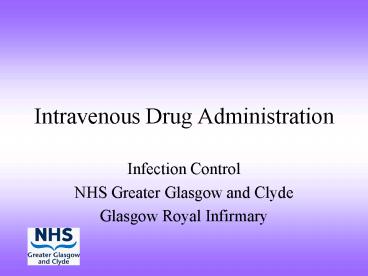Intravenous Drug Administration - PowerPoint PPT Presentation
1 / 20
Title:
Intravenous Drug Administration
Description:
discuss the way intravenous drug administration can cause infection; ... Have a clean trolley/surface area. Prepare. alcohol hand gel. drug required. alcohol wipes ... – PowerPoint PPT presentation
Number of Views:1682
Avg rating:3.0/5.0
Title: Intravenous Drug Administration
1
Intravenous Drug Administration
- Infection Control
- NHS Greater Glasgow and Clyde
- Glasgow Royal Infirmary
2
Learning Outcomes
- discuss the way intravenous drug administration
can cause infection - identify potential entry points where organisms
may gain access to the system - state how line/infusate sepsis can be detected.
- describe how risks of infection in intravenous
drug administration and line use can be minimised
3
IV Drug Administration
- Potentially the most life threatening of all
- nursing interventions.
- Be aware of all potential hazards.
- Take great care to prevent complications.
4
Potential Implications
- Pain
- Infection
- Delay in further intervention
- Side effects of antibiotics
- Delay in discharge
- Death
Patient
5
Potential Implications
- Division
- Sundries
- Increased medical and nursing intervention
- Delay in discharge/next admit
- Resistant organisms
- Litigation
6
Where organisms gain entry
7
From the infusate
- Through contamination of the infusate
- Most at risk are long term (gt10 hour) infusates
- Specifically those made up in-house
- Time for small numbers of organisms to grow
profusely. - Direct infusion of organisms severe sepsis
- Particularly some Gram negative organisms which
grow well in solutions.
8
Solutions which increase growth potential
- TPN
- Blood and blood products
- Lipid emulsions/drugs
9
Complications
- Phlebitis
- Catheter related sepsis
- Infusate Contamination
10
Preparation
- Have a clean trolley/surface area
- Prepare
- alcohol hand gel
- drug required
- alcohol wipes
- needle, syringe and if required new
- connection
- gloves
- sharps bin
11
- Never reuse single use vials
- Never prepare drugs in advance
12
- Hand hygiene
- Check solution is clear
- Disinfect ampoule
- Disinfect the hub
- Put on gloves
- Administer drug
13
- Use non-touch technique of equipment/drugs in
contact with the internal lumen of the cannula. - Avoid infusing drugs into the port on top of the
venflon.
14
After Care
- Discard sharps immediately.
- Remove gloves and wash hands.
- Record as necessary.
- Watch for signs of sepsis.
- If on a pump/TPN, central line - four hourly temp
chart. - Venflon care plan.
15
Giving sets
- Change giving set after administration of blood
or blood products - After 24 hours of TPN administration
- After 72 hours if clear fluids are used
- Use filters if infusing in-house prepared
infusions lasting longer that 12 hours - All in-house infusion should be changed after 24
hours
16
Infusate Sepsis
- 10 hours after infusion 3 commenced patient
spiked a temp. - Patient pulled out venflon.
- Venflon resited same infusion recommenced.
- Temp spiked again, blood cultures taken.
- Environmental Pseudomonas sp isolated from blood.
17
Treatment
- Stop the infusion - inform medical staff
- Send the infusate for culture.
- Send blood cultures swab from site.
- Monitor vital signs.
- Remove the line - send tip.
18
Dressings
- Not the most important factor.
- Dry dressings - do not alter skin flora
- Film dressings can increase skin flora
- Non-sterile tape - no evidence against for
peripheral veins. - Dont store tape in pockets.
19
Key points
- intravenous drug administration if not done
properly can cause infection - hand hygiene, aseptic technique, correct
preparation and administration of
iv.drugs/solutions and line changes will minimise
the risk of infection - patients should be closely monitored for signs
of infection
20
Most Important Factor
- Remember
- What have you just done?
- What are you going to do?
- Hand Hygiene

